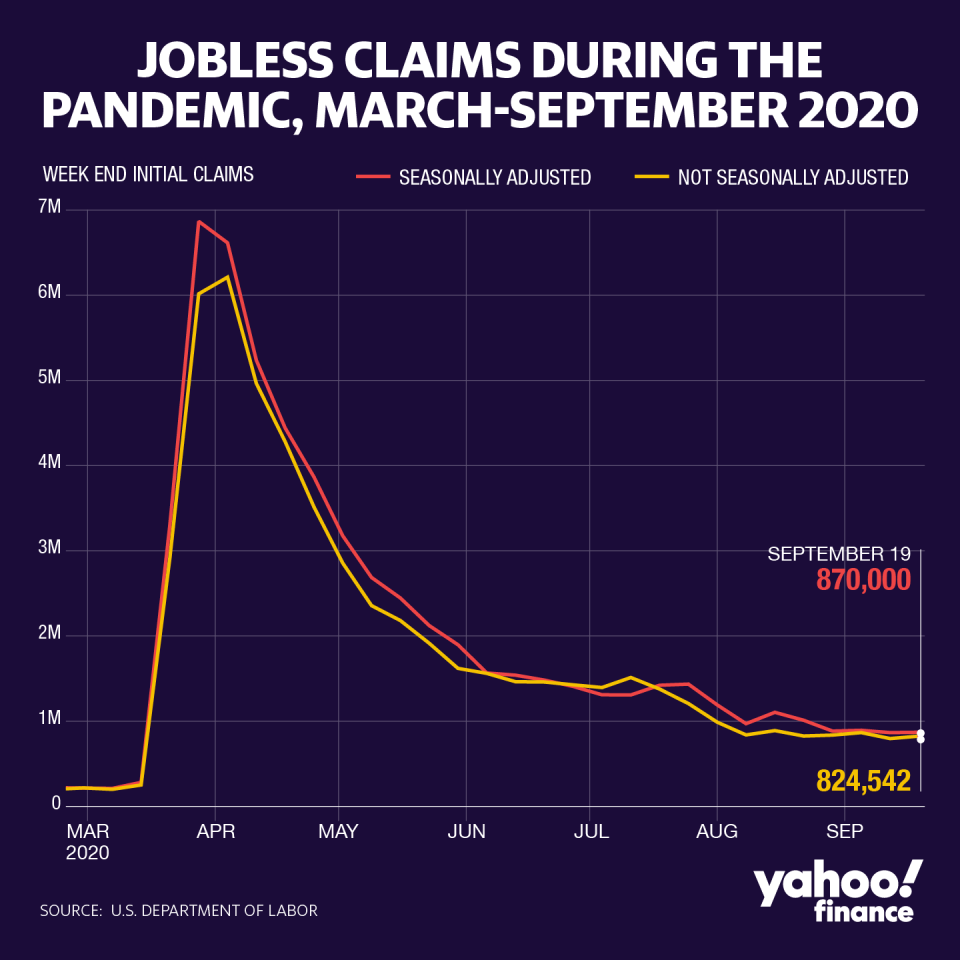Coronavirus stimulus: A new deal remains uncertain as extra unemployment benefits run out
The extra unemployment benefits under the president’s memorandum have now mostly expired, leaving millions of Americans with less income. Another stimulus deal could provide more benefits, but the chances of an agreement before the election are fading.
At least 26 states have paid out all their funds available under the Lost Wages Assistance (LWA) program, while the rest continue to pay out previous weeks up to September 5 — when the program effectively expired.
“We were technically out of money weeks ago,” Michele Evermore, a senior policy analyst at the National Employment Law Project, told Yahoo Money. “So the states that are paying are just paying old past few weeks.”

The exhausted funds come as over 26 million Americans continue to rely on unemployment benefits and 870,00 jobless workers filed for initial benefits last week, a staggering level six months into the coronavirus pandemic.
At the same time, stimulus negotiations have been in a stalemate for nearly two months as the two parties couldn’t agree on the price tag of the deal or some provisions. House Speaker Nancy Pelosi (D-CA) and Treasury Secretary Steven Mnuchin confirmed on Thursday that they’ll soon resume talks but whether progress will be made remains unclear, especially before the election.
“The chances of a deal are already low,” Sarah Binder, a professor of political science at George Washington University and senior fellow at the Brookings Institute, told Yahoo Money.
‘Spotty, awkward and slow’
The LWA program provided a total of six weeks of extra unemployment benefits for the majority of states and was distributed unevenly across the country. People in some states got $300, while others received $400. South Dakotans got no extra benefits after their governor declined to participate in the program.
“The White House thinks that they solved the problem with this Lost Wages Assistance, which was spotty, awkward and slow,” Evermore said. “It seems unlikely that Congress is going to act before the election.”

While the program lasted effectively six weeks, no other legislation has passed to replace it in the near future. The latest Republican proposal — which was rejected in the Senate — included expanded unemployment benefits of $300 a week until the end of the year.
Read more: Coronavirus stimulus checks: What’s stopping a second round of payments?
There’s also a $1.5 trillion middle-ground stimulus proposal unveiled by a bipartisan group that was applauded by the White House. Under the plan, $120 billion would be allocated for unemployment assistance, with workers getting an extra $450 a week for eight weeks starting in mid-October. That would be followed by up to $600 a week — not to exceed 100% of a person’s previous wage — through January 2021.
But the proposal didn’t get much traction after the initial support from the White House.
“There’s no sign that the president is working to convince Senate Republicans to endorse a deal that includes his call for more cash payments or Mnuchin’s support for a package closer to $1.5 trillion,” Binder said.
‘That's an emergency right there’
Lawmakers will soon adjourn and campaign before the upcoming election. Congress is scheduled to recess on October 2, but the leadership will likely remain in Washington, D.C., to negotiate a stimulus package.
“Lawmakers are eager to be back in their districts and states in the run up to the elections,” Binder said. “But any deal on pandemic relief will be negotiated by party leaders and the White House, meaning that rank-and-file legislators have limited involvement in negotiating details of any deal.”
Read more: Here’s what you need to know about unemployment benefits eligibility

Pelosi told the House Democratic Caucus that the House will stay in session until a stimulus deal is reached. House Majority Leader Steny Hoyer (D-MD) said the leadership may remain in session, while lawmakers can be called back with a 24-hour notice to vote on a deal.
“The prospect of any extension of UI is fading daily,” Evermore said. “People are just not hearing from people who are truly in pain. They just think somehow because the unemployment rate dropped that everything's fine now.”
While the unemployment rate is down from its peak of 14.7% in April, August’s rate of 8.4% is the highest it has been since 2012. The unemployment rate for Blacks hasn’t recovered at the same pace, remaining at 13% in August compared with 5.8% in April before the pandemic unfolded in the U.S.
“It's 13% of Black workers,” Evermore said. “That's insane That's an emergency right there.”
Denitsa is a writer for Yahoo Finance and Cashay, a new personal finance website. Follow her on Twitter @denitsa_tsekova.
Read more:
Follow Yahoo Finance on Twitter, Facebook, Instagram, Flipboard, SmartNews, LinkedIn, YouTube, and Reddit.

 money
money 

